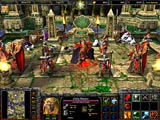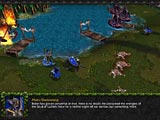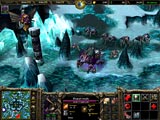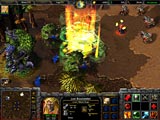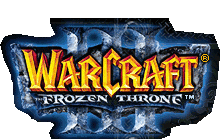
| Platform: Win 2K/ME/XP, Mac OS | Publisher: Blizzard Entertainment |
| Genre: Real-Time Strategy RPG | Developer: Blizzard Entertainment | Format: multi CD-ROM | Expected Release: July 1st 2003 |
Blizzard Entertainment is nearly ready to release an expansion pack for its real-time strategy RPG, WarCraft III: Reign of Chaos. Picking up the story a short time after the defeat of the demonic Burning Legion at the end of last summerís hit, The Frozen Throne promises to improve upon the original. The expansion contains two new single-player campaigns, new units and buildings for each race, and a number of other tweaks and enhancements to the gameís engine and world editor utility.
Reign of Chaos chronicled the exploits of four different races in the world of Azeroth, beginning with the noble, war-weary humans. The end of that campaign saw the Human Alliance champion, the young Paladin Arthas, corrupted by the cursed blade Frostmourne. The second campaign followed Arthas in his initiation into the ranks of the Undead Scourge as a Death Knight of the Lich King. Now a champion for the Undead, Arthas began the destruction of his own people to pave the way for the Legionís coming.
The story then crosses the ocean, to where the humansí old foe, the Orcish Horde, has just landed in the barren land of Kalimdor on the urging of a mysterious prophet. While the seerís warnings have gone unheeded by the humans, the Orcs still struggle with their own ties to the Burning Legion. Finally, there were the Night Elves, ancient and immortal sentinels who stood guard against the Legionís coming. Despite their differences, it would take an alliance between the humans, Orcs and Night Elves to turn back the Scourge and its Legion masters.
Even at the end, there were some loose ends to this tale. Despite the allied forcesí victory against the Legion, the Lich King escaped - his spirit sealed inside a block of ice in the frozen north. In this time, a dangerous Night Elf renegade, Illidan Stormrage had embraced the power of the demons and remained at large. WarCraft III: The Frozen Throne begins with Illidan, having made a pact with the deep water-dwelling, serpentine Naga, and Arthas, still leading the worm-ridden multitudes of the Scourge, racing to reach the Lich Kingís icy prison, the Frozen Throne, with the humans and Night Elves desperately trying to stop them. The Orcs, on the other hand, have their own separate campaign as they try to establish a homeland for themselves in the barrens of Kalimdor.
We had a chance to play quite a bit of WarCraft III: The Frozen Throne at E3 and the game looks, sounds and plays similarly to its predecessor, but with some key differences. WarCraft III has undergone a substantial overhaul for this expansion, and some of the changes are significant, especially in the element of online play. The Frozen Throne plays almost exactly the same way as the original, except with gameplay tweaks making for a faster, more fluid experience. The new units and abilities are well balanced and the game has been redesigned to allow for rapid changes in strategy and fast production, and will hopefully reduce the dominance of certain units, such as spellcasters, in the online arena.
Each race in The Frozen Throne has a new Hero unit - these elite squads also double as unique player characters that drive the gameís story in the single-player campaign. Players can control up to three of these units in either the campaign or multiplayer modes, and can be leveled-up with experience points earned through combat. Each Hero unit can also gain individual levels in three special skills until finally learning a tide-turning Ultimate technique. Heroes can also carry items - some to boost their attributes or add abilities, and others to use for healing or escape. The level progression of the hero unit is so similar to a traditional RPG that the occasional infantry mission, in which the player controls the Hero and a handful of troops, feels more like an action-RPG dungeon crawl than a strategy game.
For The Frozen Throne, Blizzard has added a number tweaks and improvements to each race as well as some sweeping changes to the gameplay. The cost and construction time for units and structures has been reduced dramatically, though the wood costs have been raised. With the proper upgrade, regular units can now carry items - though they canít use them. There is a new armor-type (Unarmored) which takes more damage from certain units, and a new damage-type (Magical) which inflicts more or less damage on certain units and structures to better balance out the multiplayer abuse of Reign of Chaosí powerful spellcaster units. Finally, the expansion introduces Neutral Heroes, which can be hired from a tavern in the multiplayer mode and will play a role in the campaign storyline.
The expansion will feature two new units for each race, a new shop building that sells unique items and a new Hero among other added abilities. The Human Alliance is joined by the fiery Blood Elves, who bring the flame-wielding Blood Mage Hero and the magic-immune, spell-stealing Spell Breakers into the fray, as well as gaining air support in the form of the Dragonhawk. The Undead gain the aid of the sinister Crypt Lord, a bigger version of the Crypt Fiend unit, who attacks with all sorts of unpleasant spikes and swarms of insects, and the restorative Obsidian Statue, which can morph into the Destroyer, another anti-magic unit.
The Night Elves have the Warden, who hunts Illidan with her abilities to teleport short distances and fling deadly knives. If that wasnít impressive enough, the Wardenís Ultimate technique summons a vengeful spirit to fight for her cause. The Night Elves also employ the Faerie Dragon, a unit which can damage active spellcasters and blink out of existence to avoid damage, and the massive Mountain Giants, stone-skinned juggernauts made to soak up abuse. Finally, the Orcish Horde has the Troll Shadow Hunter, with his healing, defensive and polymorphism skill. Though these abilities pale next to his Ultimate - making all nearby Orc and allied troops totally invincible, though the Shadow Hunter remains vulnerable. The Orcs can also train the Troll Batrider, a flying, anti-air siege unit, and the Tauren Spirit Walker, which can dispel magic, redirect damage and revive fallen Tauren units.
Finally, there are five new Neutral Heroes in The Frozen Throne to give players a way to even the playing field between sided Heroes. Thereís the drunken Pandaren Brewmaster, the weather-controlling Naga Sea Witch, the corrupt Dark Ranger, the naturalist Beastmaster and the Pit Lord, a demonic holdover. Their own unique abilities and Ultimate techniques make for a much greater variety in Hero combination strategies.
WarCraft III blurred the line between traditional real-time strategy games and action RPGs considerably, and the distinction gets even vaguer with this upcoming expansion. With its detailed story continuation, in-mission side quests and a plethora of other RPG elements, WarCraft III: The Frozen Throne should make strategy and RPG fans-alike very happy when the expansion hits retailers on July 1st. © 2003 Blizzard Entertainment. All Rights Reserved. |
|

